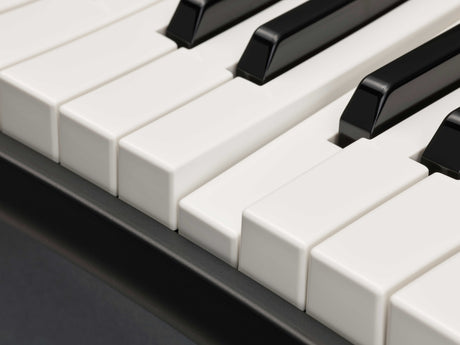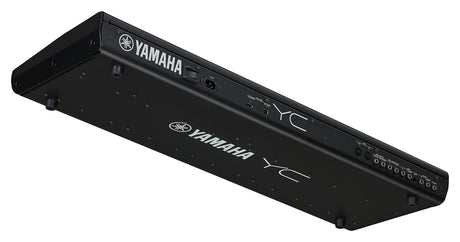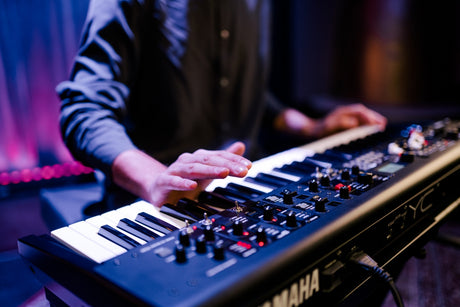Electronic Organs
- Highlighted
- Bestsellers
- Alphabetical, A-Å
- Alphabetical, Å-A
- Price, low to high
- Price, high to low
- Date, older to newer
- Date, newer to older
FiltersFilter & sorting
- €1.945,68
€2.334,82Unit price /Not available Yamaha YC61 Digital Stage Keyboard (Waterfall)
In stock (1 item)€1.957,30Unit price /Not availableYamaha YC73 Digital Stage Keyboard (Balanced Hammer)
In stock (1 item)€2.392,90Unit price /Not availableYamaha YC88 Digital Stage Keyboard (Natural Wood)
In stock (1 item)€3.044,36Unit price /Not available

Join Club SoundStoreXL
- and gain access to unique perks
- Exclusive benefits
- Early Bird access to deals
- Unique coupon codes for members
- It's completely free to join!
Understanding the basics of an electric organ and its functionality
An electric organ is a versatile musical instrument that combines the rich tonal qualities of traditional pipe organs with the convenience and adaptability of electronic technology. Unlike acoustic organs, which produce sound by moving air through pipes, electric organs generate sound electronically using oscillators or digital sound synthesis. This technology allows for a wide range of sounds and effects, making the electric organ a popular choice for various musical genres, from classical and jazz to gospel and rock.
The basic functionality of an electric organ revolves around its keyboard, which controls the electronic circuits that generate sound. When a key is pressed, it triggers an electrical signal that is processed by the organ's sound engine to produce the corresponding note. Many electric organs also feature multiple keyboards, known as manuals, as well as a pedalboard for bass notes. These components allow musicians to create complex, layered textures that are characteristic of organ music.
Different types of electric organs and their features
Electric organs come in various types, each designed to meet different musical needs and preferences. The most common types include Hammond organs, combo organs, and digital organs. Each of these has unique features that make them suitable for specific styles of music and performance settings. Hammond organs are perhaps the most iconic type of electric organ, widely used in jazz, blues, and rock music. These organs are known for their distinctive tone, produced by a combination of tonewheels and an electronic amplifier. The Hammond organ’s drawbars allow players to shape the sound by adjusting the harmonic content of each note, making it a highly expressive instrument. Combo organs, popular in the 1960s and 1970s, were designed to be portable alternatives to larger, more cumbersome organs. They were commonly used in rock and pop music, thanks to their bright, reedy sound. Combo organs are typically more straightforward in design, with fewer features than Hammond or digital organs, but they are valued for their simplicity and portability. Digital organs represent the latest evolution in organ technology. These instruments use digital sampling and synthesis to replicate the sounds of traditional pipe organs and other classic electric organs. Digital organs offer a wide range of voices and effects, making them incredibly versatile. They are often used in churches and concert settings where the authenticity of traditional organ sounds is desired without the maintenance and space requirements of pipe organs. Choosing between these types of electric organs depends largely on the intended use and the specific sound you are looking to achieve. Whether you are interested in the classic tones of a Hammond, the portability of a combo organ, or the versatility of a digital organ, understanding the different types of electric organs and their features will help you make an informed decision.
How to choose the right electric organ for your needs
Selecting the right electric organ requires careful consideration of several factors, including your musical style, budget, and the intended use of the instrument. For those new to the world of electric organs, it’s important to start by defining what you need the organ for. Are you looking for an instrument to use in a church setting, a home studio, or live performances? For beginners, a digital organ might be the best choice due to its versatility and ease of use. Digital organs often come with built-in learning tools and a wide range of sounds, making them ideal for those who are still exploring their musical preferences. Understanding how to choose the right electric organ for beginners involves considering factors like the number of keys, the quality of sound, and the availability of support and learning resources. If you’re looking for an organ to use in a church or a more traditional setting, you might consider a digital organ that replicates the sound of a pipe organ. These organs are designed to provide the rich, full tones associated with traditional church music, but with the convenience of modern technology. On the other hand, if you’re a professional musician, you might prefer the authentic sound and feel of a Hammond organ, which is renowned for its use in jazz, blues, and rock music. Budget is another critical factor when choosing an electric organ. Prices can vary widely depending on the type of organ and its features. While it might be tempting to go for the most affordable option, it’s important to consider the long-term investment. A higher-quality organ will not only sound better but will also last longer and offer more features that can enhance your playing experience. Whether you’re considering the best electric organ for home use or a professional-grade instrument, taking the time to research and compare options will ensure you make the right choice.
The benefits of using an electric organ in modern music
The electric organ has become an indispensable tool in modern music, offering a range of benefits that make it a valuable addition to any musician’s arsenal. One of the primary advantages of the electric organ is its versatility. Unlike traditional acoustic organs, which are limited by their physical design, electric organs can produce a wide variety of sounds, from classic organ tones to innovative electronic effects. This versatility makes the electric organ suitable for a wide range of musical genres. In jazz, for example, the electric organ’s ability to produce warm, expressive tones makes it a favorite for both solo performances and ensemble settings. In rock music, the electric organ’s powerful, cutting sound can add depth and energy to a band’s performance. Understanding the benefits of using an electric organ in modern music can help musicians explore new creative possibilities and expand their musical repertoire. Another key benefit of the electric organ is its portability. Traditional pipe organs are massive, immovable instruments that are typically installed in churches or concert halls. In contrast, electric organs are designed to be portable, allowing musicians to take their instrument with them to gigs, recording sessions, or rehearsals. This portability, combined with the organ’s rich sound, makes it an excellent choice for live performances. Additionally, electric organs are often equipped with modern features such as MIDI compatibility, allowing them to be integrated into digital music production setups. This opens up even more creative possibilities, enabling musicians to combine the organic sound of the organ with digital effects and synthesizers. Whether you’re composing, recording, or performing live, the electric organ offers a unique blend of tradition and innovation that can enhance your music.
How to connect your electric organ to sound systems and amplifiers
Connecting an electric organ to a sound system or amplifier is a crucial step in ensuring that your instrument sounds its best during performances or recording sessions. The process can vary depending on the type of organ and the equipment you’re using, but understanding the basics will help you achieve the best possible sound quality. Start by identifying the outputs on your electric organ. Most modern electric organs are equipped with standard audio outputs, such as 1/4-inch jacks or XLR connectors, that can be connected to amplifiers, mixers, or sound systems. If your organ has multiple outputs, you may be able to connect it to both an amplifier and a PA system simultaneously, giving you greater control over your sound. Once you’ve identified the correct outputs, choose the appropriate cables for your setup. For short distances, unbalanced cables like 1/4-inch TS cables may be sufficient. However, for longer distances or when connecting to professional sound systems, balanced cables like XLRs are recommended to reduce noise and ensure a clean signal. After connecting the cables, adjust the levels on your organ and amplifier or mixer to avoid distortion. Start with the volume controls on your organ set to a low level, then gradually increase the volume on your amplifier or mixer until you achieve the desired sound. If your organ has a built-in preamp, you may need to adjust its settings as well to match the input levels of your sound system. It’s also important to consider the acoustics of the room where you’re playing. Different spaces can affect how the sound from your organ is perceived, so take the time to experiment with speaker placement and EQ settings. Understanding how to connect your electric organ to sound systems and amplifiers is essential for delivering a clear, powerful performance that highlights the full capabilities of your instrument.
Common mistakes to avoid when buying an electric organ
Purchasing an electric organ is a significant investment, and it’s important to approach the process with care to avoid common pitfalls. One of the most frequent mistakes buyers make is not considering the full range of features and specifications that an electric organ offers. It’s easy to be swayed by price alone, but this can lead to purchasing an instrument that doesn’t meet your needs or expectations. When buying an electric organ, it’s essential to research the different types of organs available and the specific features they offer. For example, if you’re looking for an organ to use in a professional setting, you’ll need one with high-quality sound, reliable performance, and advanced features such as MIDI compatibility and multiple outputs. On the other hand, if you’re buying an organ for home use, you might prioritize portability, ease of use, and integration with other home audio equipment. Another common mistake is neglecting to consider the size and weight of the organ. While electric organs are generally more portable than traditional pipe organs, they can still be quite large and heavy, especially models with full-size pedalboards and multiple manuals. Before making a purchase, ensure that you have adequate space to accommodate the organ and that it’s practical to transport if needed. Finally, many buyers overlook the importance of after-sales support and maintenance. Electric organs, like any electronic instrument, require regular care to maintain their performance. Choosing a reputable brand with a good warranty and access to technical support can save you a lot of trouble in the long run. By being aware of these common mistakes to avoid when buying an electric organ, you can make a more informed decision and invest in an instrument that will bring you years of musical enjoyment.





























































